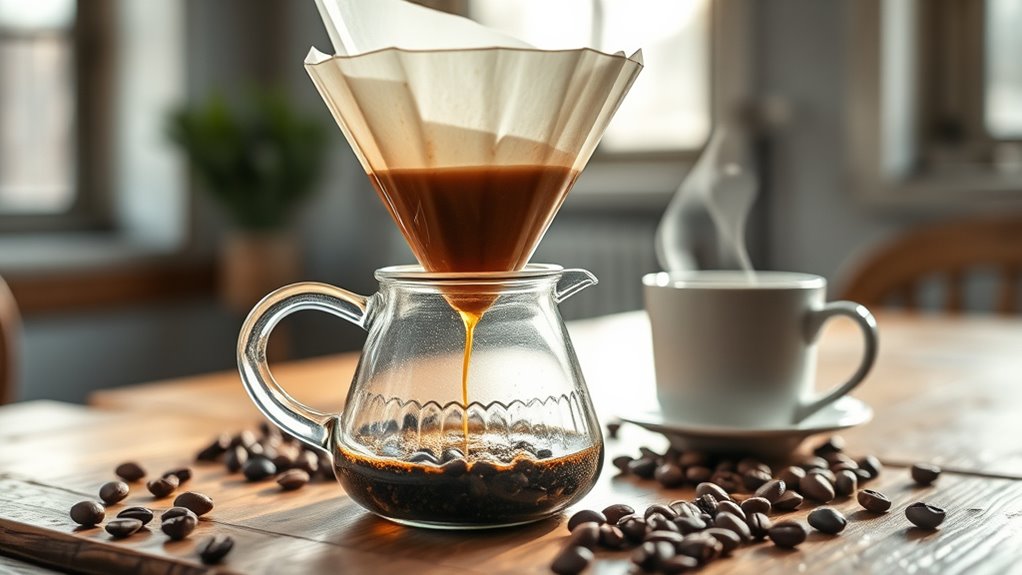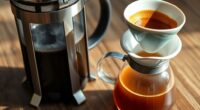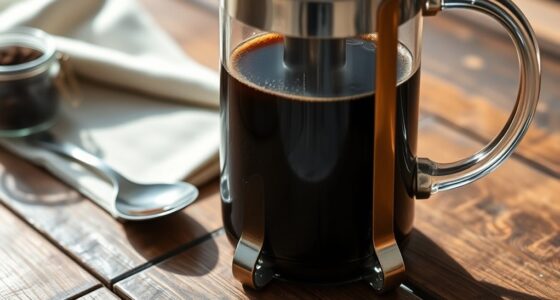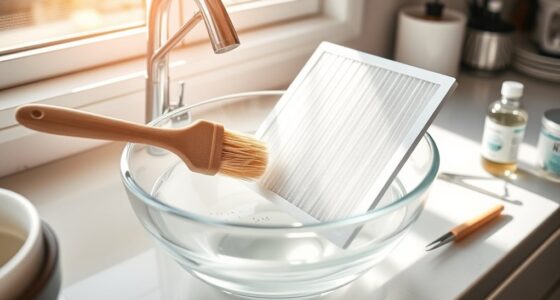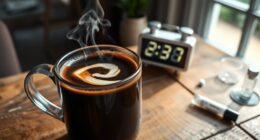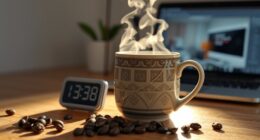Discover how to craft the perfect pour-over coffee by choosing the right device—cone or flat-bottom—using quality filters and precise equipment like burr grinders and gooseneck kettles. Master techniques such as bloom timing, controlled pouring, and maintaining ideal water temperature and grind size to release vibrant, balanced flavors. Fine-tune your process based on taste, water quality, and equipment adjustments. Keep honing your routine, and you’ll realize the full potential of pour-over coffee with every brew.
Key Takeaways
- Choose the right pour-over device shape and material to influence extraction and flavor clarity.
- Use high-quality, filtered water with proper mineral content and controlled temperature for optimal brewing.
- Master pouring technique, including bloom and concentric circles, to ensure even extraction and balanced flavor.
- Adjust grind size, brew time, and water flow to fine-tune flavor profile and prevent over- or under-extraction.
- Establish a mindful brewing routine with precise equipment for consistent, enjoyable pour-over coffee.
Exploring Different Pour-Over Devices and Their Unique Features

When choosing a pour-over device, understanding how their shapes and designs affect brewing is essential. Cone-shaped brewers like the Hario V60 and Chemex direct water flow toward the center, creating a powerful extraction and clear flavor. Flat-bottom options like the Kalita Wave and Tricolate distribute water more evenly across the brew bed, promoting consistent extraction. Device features such as ridges, holes, and shape design influence how water interacts with the coffee grounds, impacting contact time and flavor clarity. Material also matters—ceramic, glass, metal, or plastic—affect heat retention and durability. A well-designed shape ensures proper water flow and ideal extraction, enhancing your brewing experience. Understanding brew efficiency can help you optimize your setup for better flavor and consistency. Choosing the right shape and features helps you control brew time, flavor profile, and ease of use.
Essential Equipment for Consistent and Precise Brewing

Achieving consistent and precise pour-over coffee relies heavily on selecting the right equipment. Start with a burr grinder, like the OXO Brew Conical Burr Grinder, to produce uniform coffee grounds for even extraction. Use a gooseneck kettle, such as the Fellow Stagg EKG, with adjustable temperature control to manage water flow and maintain water at the ideal temperature. A digital scale with a built-in timer, like the OXO Brew Precision Scale, helps you measure coffee and water accurately, ensuring proper ratios. Rinsing filters thoroughly prevents papery flavors and promotes even water flow, enhancing flavor extraction. Preheating your brewing equipment and vessel with hot water stabilizes temperature throughout the process, resulting in a consistently balanced cup. Proper water temperature is crucial for optimal extraction and flavor clarity in pour-over brewing.
Understanding the Science Behind Pour-Over Extraction
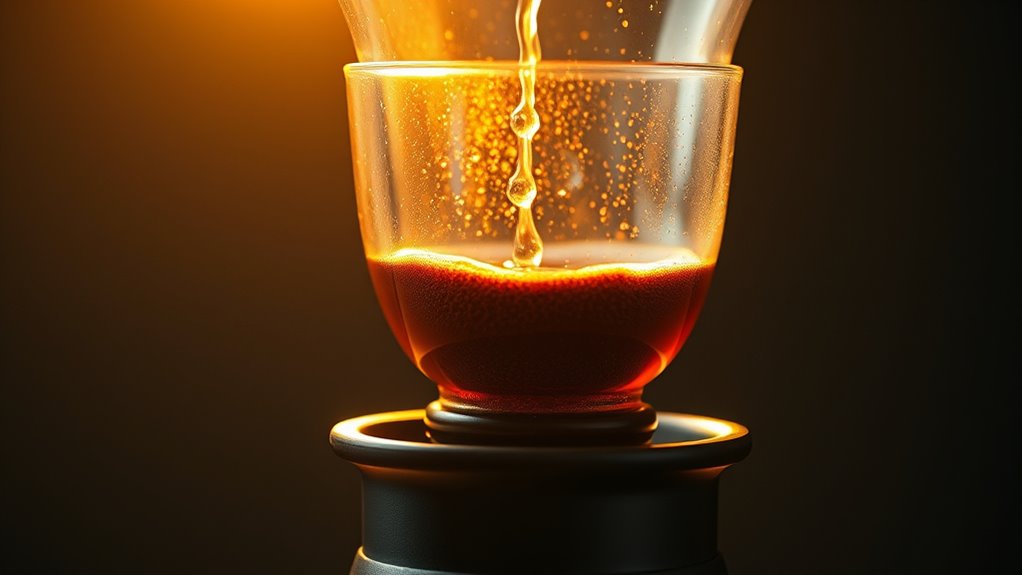
Understanding the science behind pour-over extraction reveals how precise control over water flow, temperature, and contact time shapes the final flavor. When you pour, water interacts with coffee grounds, dissolving soluble compounds that create flavor. The grind size influences flow rate and contact time—too fine causes slow flow and possible channeling, while too coarse leads to under-extraction. Proper brew time ensures ideal extraction of 19-22% of solubles, balancing richness and bitterness. The shape of your pour-over device affects how evenly water contacts the grounds, preventing uneven extraction. Key factors to visualize include:
- Controlled water flow prevents channeling and ensures uniform extraction
- Adjusting grind size influences flow rate and contact time
- Proper brew time maximizes solubles extraction without overdoing it
- Precision in technique is essential for achieving consistent and optimal flavor profiles.
Step-by-Step Process for Perfecting Your Brew Technique
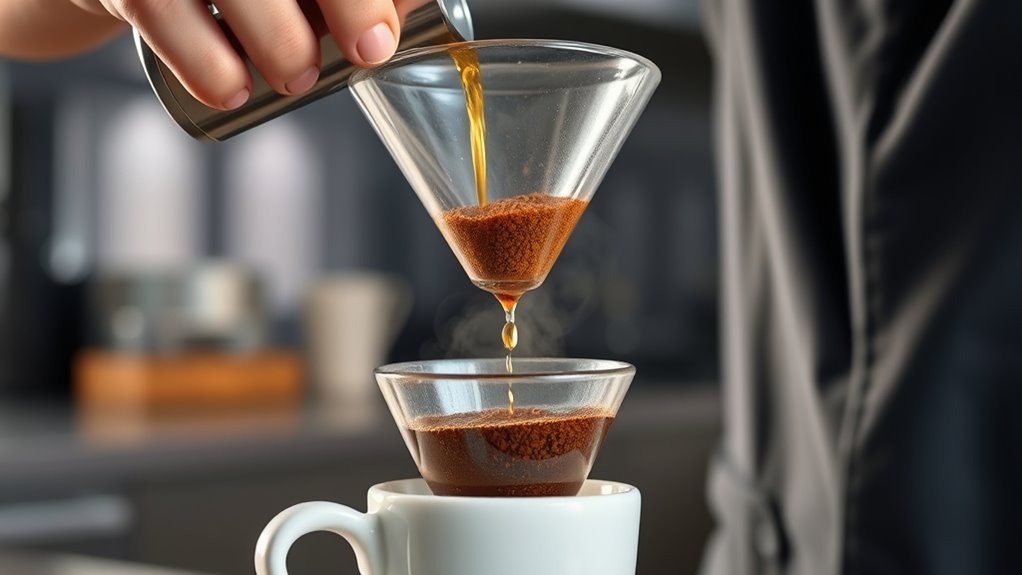
To brew the perfect cup using pour-over, start by heating your water to about 205°F and measuring both coffee and water carefully to maintain a consistent ratio, typically between 1:15 and 1:17. Rinse the filter thoroughly with hot water to eliminate paper taste and preheat the dripper and vessel for better temperature stability. Add freshly ground coffee with a medium grind size to the filter, then create a small well and pour double the weight of coffee in water to bloom for 30-45 seconds, allowing gases to escape. Next, slowly pour the remaining water in concentric circles, controlling the flow to ensure even extraction. Aim for a brew time of 3-4 minutes, adjusting pour technique or grind size as needed. Proper color accuracy in your brewing process can also enhance the visual appeal of your coffee, making each cup more inviting.
Mastering Grind Size and Water Temperature for Optimal Flavor
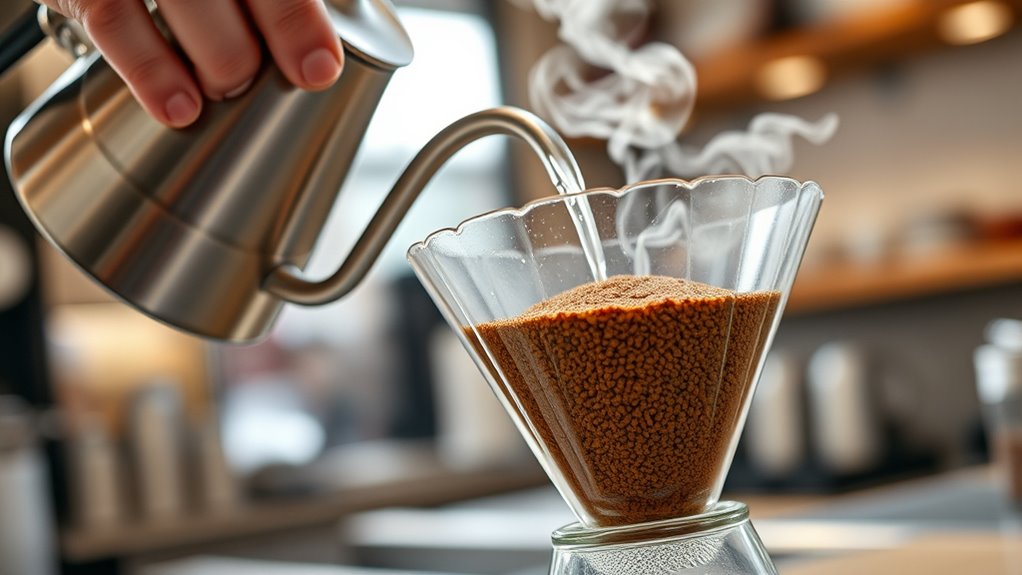
Mastering grind size and water temperature is essential for revealing the full potential of your pour-over coffee. Your grind size directly impacts extraction time—finer grinds speed up extraction, while coarser ones slow it down. Water temperature influences flavor, with about 205°F enhancing brightness and body, and around 195°F reducing bitterness. To achieve the best flavor profile, aim for a consistent grind similar to sea salt, ensuring uniform particles for even extraction. Monitoring brew time, typically 3 to 4 minutes, helps you fine-tune your process. Adjusting grind size and water temperature prevents over-extraction, which causes bitterness, or under-extraction, which results in sourness. Proper control over these variables guarantees your coffee’s flavor remains balanced and vibrant. Incorporating proper textiles and accessories can also help keep your brewing area organized and inviting, enhancing your overall coffee experience.
The Art of Pouring: Techniques for Even Saturation and Extraction
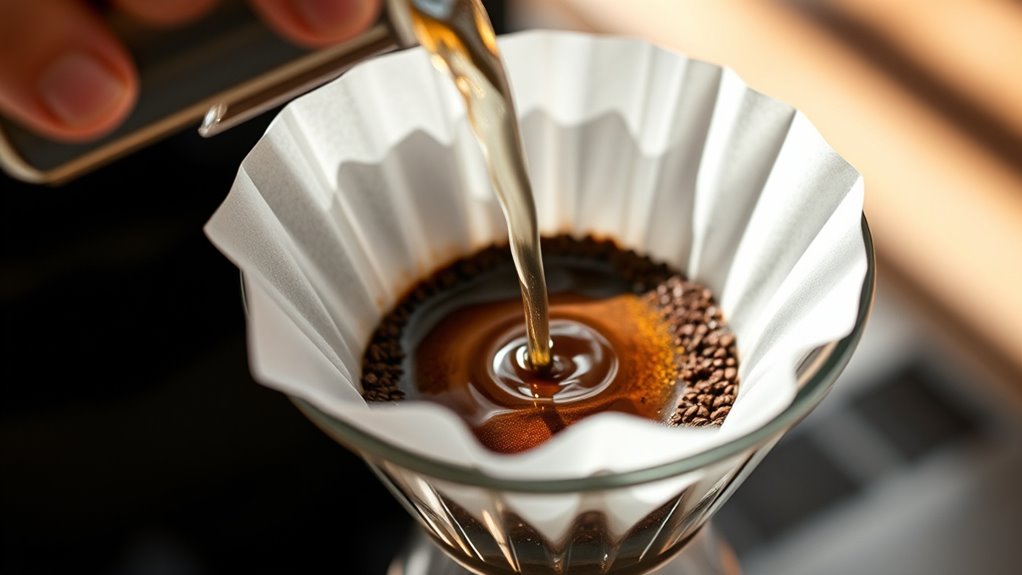
Achieving even saturation during your pour-over process hinges on precise pouring techniques that promote uniform extraction. You should pour water in a slow, steady spiral from the center outward, ensuring all grounds are evenly soaked. Using a gooseneck kettle helps maintain a controlled flow, allowing for gradual pouring rather than rapid streams. Aim for about 1-2 seconds per ounce of water to keep the pour consistent and prevent channeling. Pause briefly after each pour to let the water drain through the grounds fully before adding more, which fosters even saturation. Gently swirling or agitating the brew during pouring distributes water evenly and minimizes uneven extraction or channel formation. Incorporating décor elements similar to those in farmhouse bedrooms can enhance your brewing space, creating a cozy and inviting environment. Mastering these pour techniques enhances your brew method, resulting in a balanced, flavorful cup.
Troubleshooting Common Issues and Adjusting Variables
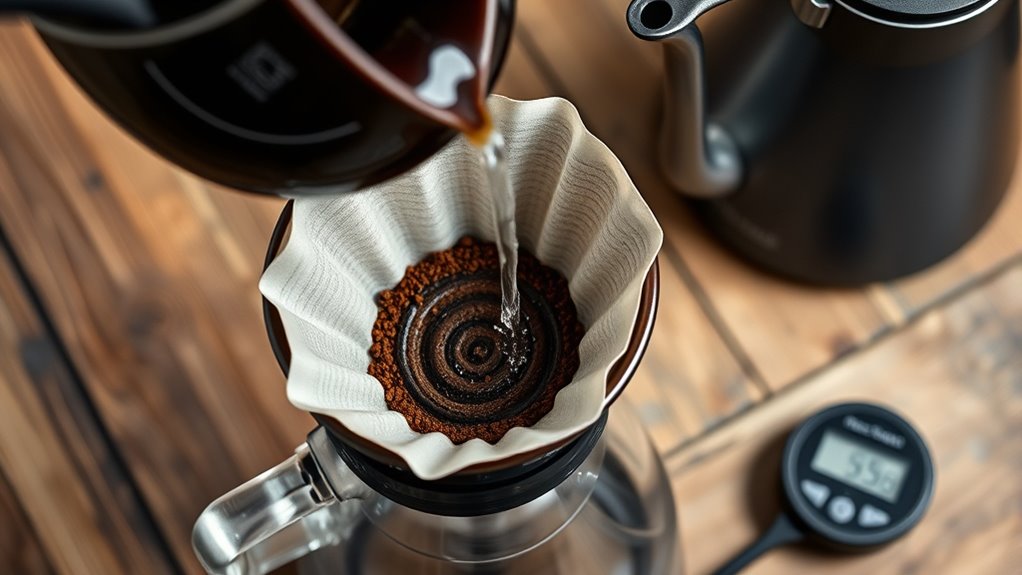
If your coffee tastes off, adjusting your grind size can make a big difference—coarser for sourness, finer for bitterness. Ensuring a slow, even pour helps prevent uneven extraction and channeling, which can cause flavor issues. Experiment with brew time and water temperature to fine-tune your results and achieve balanced, delicious coffee. Additionally, being aware of tools and materials required such as a proper grinder and kettle can help you make precise adjustments for optimal flavor.
Common Flavor Imbalances
Common flavor imbalances in pour-over coffee often result from how variables like grind size, brew time, and water temperature are adjusted during extraction. If your coffee tastes sour, try a finer grind, extend brew time, or slightly raise water temperature to promote proper extraction. Bitter notes usually indicate over-extraction, which you can fix by coarsening the grind, reducing brew time, or lowering temperature. Channeling causes uneven extraction, leading to inconsistent flavors; ensure an even pour and proper filter placement to prevent this. A weak or watery cup often results from too coarse a grind or too little coffee, which can be corrected by grinding finer or increasing the coffee dose. Properly balancing these variables ensures a more consistent and flavorful brew. Additionally, understanding the importance of proper equipment and regular cleaning can significantly improve extraction consistency and flavor clarity.
Fine-Tuning Brewing Variables
Fine-tuning your brewing variables is key to resolving flavor issues and enhancing your pour-over coffee. Start by adjusting the grind size—finer for increased extraction if your brew tastes sour, or coarser to reduce bitterness. Keep water temperature between 195°F and 205°F to control flavor clarity; higher temps extract more, while lower temps mellow flavors. Pay attention to brew time: too short can cause under-extraction, too long leads to over-extraction. Improve your water pouring technique by pouring evenly and slowly to prevent channeling, which causes uneven extraction. Guarantee your coffee-to-water ratio is precise for consistent results. Additionally, maintaining proper water temperature can significantly influence extraction quality. By monitoring these variables and making small adjustments, you optimize extraction and achieve a better flavor balance in every cup.
Tasting Notes and How to Refine Your Coffee Profile
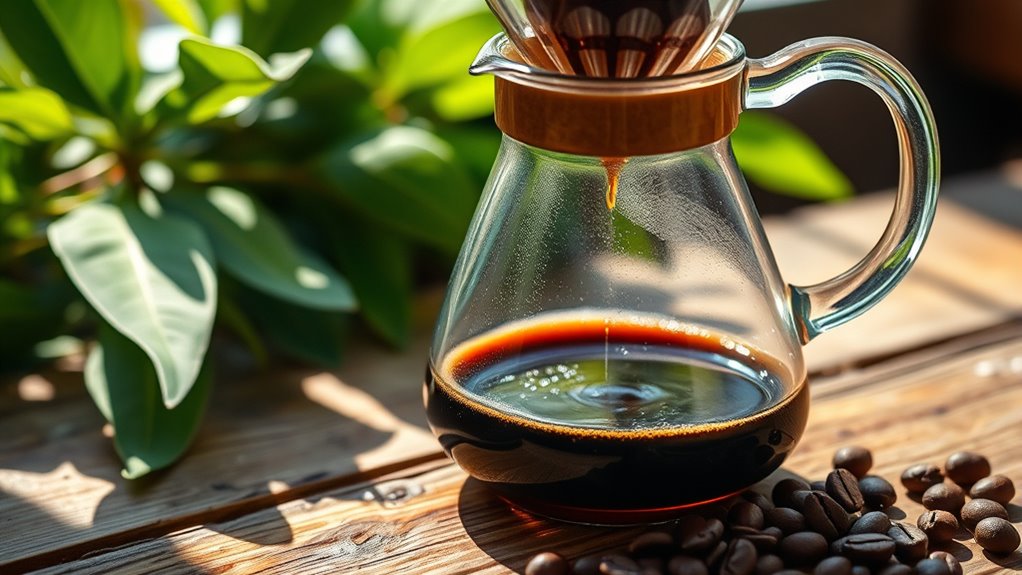
Understanding your coffee’s tasting notes—such as brightness, acidity, body, and flavor clarity—relies on observing how variables like grind size, water temperature, and pour technique influence the final flavor. By paying attention to these factors, you can identify if your brew is under- or over-extracted, affecting the flavor profile. Adjustments in grind size and brew time help fine-tune extraction, balancing acidity and richness. Your pouring technique, including pour rate and pattern, impacts saturation and extraction consistency, shaping the flavor balance. Regular tasting and note-taking are essential for refining your profile. Focus on these key points:
- Fine-tune grind size and brew time to enhance tasting notes
- Modify pouring technique for even extraction
- Use notes to make precise adjustments to improve flavor profile
- Understanding pour-over coffee techniques and variables can significantly elevate your brewing skills.
Incorporating Filter and Water Quality for Better Results
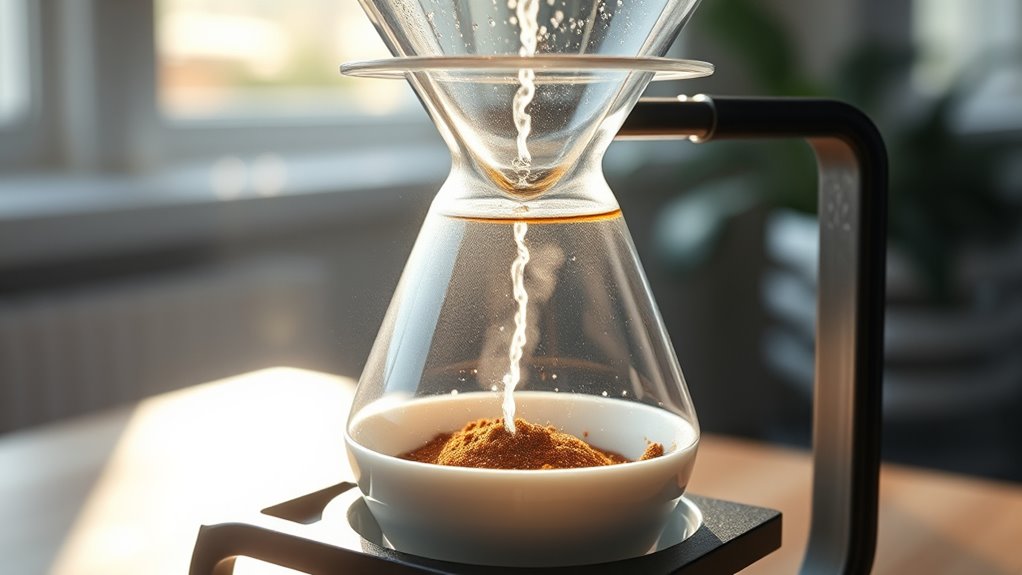
Choosing the right filter material affects how quickly water flows and how clean the final flavor is. Using high-quality, filtered water with balanced minerals boosts extraction and enhances taste clarity. Pay attention to your filter and water quality to consistently improve your pour-over results.
Filter Material Effects
The material of your pour-over filter plays a crucial role in shaping the flavor and clarity of your coffee. Different filter materials, such as paper, metal, or cloth, affect extraction by altering flow rate, sediment retention, and flavor clarity. For example, paper filters have small pore sizes that trap oils and fine particles, producing a cleaner, brighter cup. Metal filters, with larger pores, allow more oils and sediment through, resulting in a fuller-bodied brew. Cloth filters offer a middle ground, balancing clarity and richness. Your choice impacts flow rate and mineral content interaction, influencing flavor balance. Consider how filter material interacts with your water quality to optimize extraction, ensuring a well-rounded, flavorful pour-over experience.
Water Mineral Balance
Achieving the perfect pour-over cup depends heavily on using water with the right mineral balance, as it directly influences extraction efficiency and flavor clarity. Water mineral content, ideally between 150-250 ppm, helps extract soluble compounds without overpowering the coffee’s nuances. Proper filtration can improve water quality, reducing impurities and maintaining the ideal mineral balance. Water hardness, rich in calcium and magnesium, enhances body and mouthfeel but may cause scale buildup in your equipment, so consider softening or filtering hard water. Maintaining a balanced pH level—around 6.5 to 7.5—ensures optimal flavor extraction. Regularly testing and adjusting your water’s mineral levels and pH helps produce consistent, well-rounded brews and prolongs the lifespan of your equipment.
Tips for Creating a Ritual and Enhancing Your Pour-Over Experience
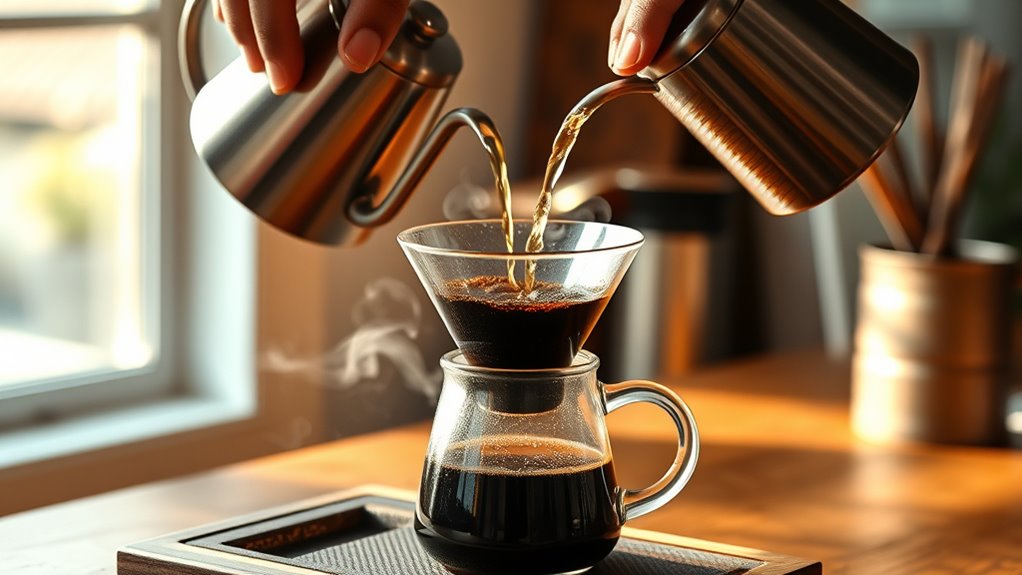
Creating a mindful pour-over ritual begins with establishing a consistent process that enhances both flavor and enjoyment. Focus on a deliberate pour, slow and steady, to deepen your attention and make the brewing process meditative. Set up a dedicated space with all your equipment prepared beforehand to create a focused, ritualistic environment. Use a gooseneck kettle for precise control, ensuring smooth, even saturation. Incorporate pauses between stages to observe the bloom, water flow, and color changes—these small acts heighten your appreciation and flavor awareness. Building a consistent routine transforms brewing into a calming practice, where attention and patience truly enhance your coffee experience.
- Prepare your setup in advance for a focused environment
- Use a slow, deliberate pour to deepen attention
- Observe each stage to heighten sensory awareness
Frequently Asked Questions
How to Make the Perfect Pour Over Coffee?
Imagine a steady stream of warm, aromatic water cascading over vibrant coffee grounds, awakening rich flavors. To make perfect pour-over coffee, use a burr grinder for consistent medium grounds, pre-wet the filter, and preheat your brewer. Start with a bloom, then pour slowly in circles, maintaining water temperature between 195°F-205°F. Aim for a total brew time of 3-4 minutes, adjusting as needed for balanced, flavorful coffee.
What Is the Formula for Pour Over Coffee?
The formula for pour-over coffee is simple: use about 1 gram of coffee for every 16 to 17 grams of water. Start with 20 grams of coffee, bloom with 40 grams of water, then slowly pour until you reach roughly 320–340 grams total. Keep the grind medium to medium-fine and water between 195°F and 205°F. Follow these steps for a balanced, flavorful brew every time.
What Is the Golden Ratio for Coffee Pour Over?
The golden ratio for pour-over coffee is typically around 1:15 to 1:17, meaning for every gram of coffee, you use 15 to 17 grams of water. Many baristas start with 1:16, like 20 grams of coffee to 320 grams of water, for balanced flavor. You can tweak this slightly for a bolder or lighter brew, but sticking close to this range helps guarantee a great, consistent cup.
What Is the 4 6 Pour Over Method?
The 4-6 pour-over method involves pouring water in four to six stages, giving you better control over extraction and flavor. You start with a bloom, then pour in stages, each spaced 15-30 seconds apart, allowing the coffee to drain and avoiding over-extraction. This technique usually takes about 3-4 minutes, helping you achieve a balanced, flavorful cup by ensuring even saturation and extraction throughout the process.
Conclusion
Now that you know the ins and outs of pour-over brewing, don’t let perfection hold you back. Remember, even if your first few cups aren’t flawless, practice and adjustments will improve your results. Enjoy the process and savor each brew as you refine your technique. Coffee is about pleasure, not perfection—so relax, experiment, and let your passion for great coffee grow with every pour.
